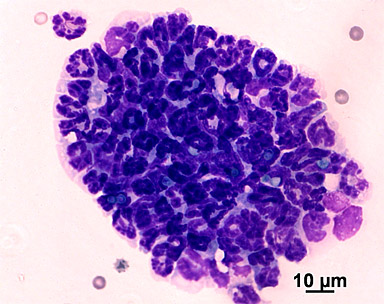Dr. Jim Burritt
Department of Microbiology, Montana State University
This image shows an aggregate of neutrophils formed in vivo in the mouse lung following exposure to A. fumigatus conidia. A number of conidia (staining light blue) can be seen among the neutrophils in the aggregate. We have observed the conidia are being killed by the neutrophils, in a process dependent upon the phagocyte oxidant generating system of the neutrophils.
Research Focus & Application:
Infections caused by Aspergillus fumigatus are a leading cause of death in immune compromised humans. The importance of neutrophils in the innate resistance to aspergillosis is shown by the fact that humans with a variety of neutrophil disorders are particularly susceptible to infections by this organism. Because there is limited information on the mechanism by which neutrophils engage and kill Aspergillus, we have examined the in vivo response of neutrophils to A. fumigatus conidia in fluid recovered from the lungs of mice after exposure to conidia.
Following instillation of 10e6 A. fumigatus conidia into the lungs of a mouse and an 8 hour in vivo incubation, lung lavage fluid was used to prepare cytospin slides which were Wright stained prior to examination by microscopy. Our analysis of these aggregates in different studies also showed that toxic oxidants were being released by the neutrophils, and that the conidia were being killed as a result of this engagement. This mechanism of killing by neutrophils, including aggregation to sequester a pathogen, has received little previous attention.
A description of these studies has been published in the following report: Bonnett, C. R., E. J. Cornish, A. G. Harmsen, and J. B. Burritt. 2006. Early neutrophil recruitment and aggregation in the murine lung inhibit germination of Aspergillus fumigatus Conidia. Infect. Immun. 74:6528-6539.
Microscopy and Imaging Methods:
The microscopy was carried out using is a ZEISS Axioskop 2 plus. This image was collected through a 100x Plan-Apochromat objective and AxioCam HRc camera. The system is dependable, easy to use and provides very good quality images in a variety of formats.



